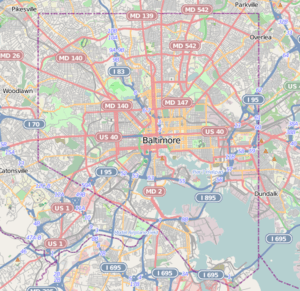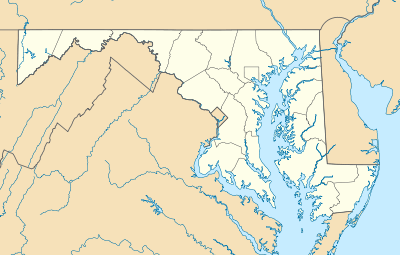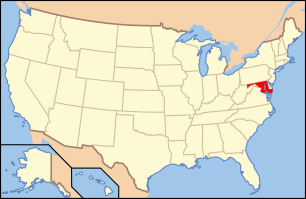President Street Station
|
President Street Station | |
|
President Street Station in 1856 | |
   | |
| Location |
President Street at Fleet Street Baltimore, Maryland |
|---|---|
| Coordinates | 39°17′4″N 76°36′9″W / 39.28444°N 76.60250°WCoordinates: 39°17′4″N 76°36′9″W / 39.28444°N 76.60250°W |
| Area | less than one acre |
| Built | 1849 |
| Architect | Parker, George A.; Isaac Ridgeway Trimble; Philadelphia, Wilmington and Baltimore Railroad |
| Architectural style | Mid 19th Century Revival, Italianate, Greek Revival |
| Restored | 1997 |
| NRHP Reference # | 92001229[1] |
| Added to NRHP | September 10, 1992 |
The President Street Station in Baltimore, Maryland, is a former train station. Built in 1850, the station was an important rail transportation link during the Civil War. Today, it is the oldest surviving big-city railroad terminal in the United States and is home to the Baltimore Civil War Museum.[2][3]
History
The Baltimore and Port Deposit Rail Road (B&PD), founded in 1832, completed a rail line from Baltimore to the western shore of the Susquehanna River in 1837.[4]:32 [5]:489 The railroad’s Baltimore terminus was on the east side of the "Basin," now known as the Inner Harbor, at the southern end of President Street. The B&PD exchanged freight cars with the Baltimore and Ohio Railroad (B&O), which had built a track (along Pratt Street) to the east Basin area from its original Mount Clare depot on the western side of the business district.[4]:31–2[6]:144 The B&PD and its successor company, the Philadelphia, Wilmington and Baltimore Railroad (PW&B), transferred passengers to the B&O downtown depot at Pratt and Charles streets by a horse-drawn car on B&O's connecting track. (The city prohibited the operation of locomotives on this track.)[4]:32 By 1838, the PW&B was carrying passengers from Philadelphia to Baltimore, where they could transfer to the B&O and continue to Washington, D.C.[7]
The PWB started building its own station at President Street in 1849.[8]:3 The Greek Revival-style station opened on February 18, 1850.[9][10] In addition to the brick head house, the original station also had a 208 feet (63 m) long barrel vaulted train shed over the tracks.[11] The PW&B added a freight house, to the south of the passenger station, in 1852.[8][12]
The station was involved in the Baltimore riot of 1861, when Massachusetts troops bound for Washington were marching to the B&O Camden Station ten blocks west and were attacked by an angry mob of Southern sympathizers, with several people killed in the ensuing melee.[11][13][14]

In 1873, the Union Railroad built a new set of tracks in Baltimore, connecting the original PW&B main line with the Northern Central Railway (NCRY). The new connection ran through Union Tunnel to NCRY’s new Charles Street Station.[5]:488 (This station was rebuilt twice, as "Union Station" and ultimately "Pennsylvania Station".) Charles Street Station and its successors largely replaced the President Street Station for passenger service. The latter continued to serve as a freight station, but served some passenger trains until 1911.[15] The Pennsylvania Railroad, which acquired the PW&B in 1881, demolished the President Street train shed in 1913 and erected a new, shorter shed, built with wooden trusses.[8]:4
Post-railroad use
The President Street Station was later used as a warehouse. The train shed was destroyed by fire, leaving only the present head house by 1970, when it was abandoned.[11] In 1979, the derelict building was acquired by the City of Baltimore, which planned to demolish it to clear the way for a proposed extension of Interstate 83, which was never built.[11] In 1989, the station’s wooden arched roof collapsed in a snowstorm.[16]
As a museum

In the 1990s, a public-private partnership funded the restoration of the vacant station, which reopened in 1997 as the Baltimore Civil War Museum.[2][11] President Street Station, Inc. operated the museum until 2000, when the building lease was taken over by the Maryland Historical Society (MHS). The lease expires in 2017.[17] The museum closed in 2007, then re-opened on weekends only, operated by MHS and subsequently by volunteers from the Friends of President Street Station.[13][18][19] The Civil War Museum was open on weekends in February 2010, in observance of Black History Month, although heavy snowfall forced closure of the museum on two weekends.[9]
The future of the historic property is uncertain: the City of Baltimore announced plans in 2009 to designate the old depot as a landmark, which would restrict modifications to the building's exterior. But plans by the city to advertise a request for proposals (RFP) in 2009 for commercial development of the grounds are opposed by the Friends of the President Street Station group. They have called instead for the station's preservation and management as a museum by the National Park Service (NPS).[20] The director of Baltimore's Commission for Historical and Architectural Preservation, which will review the RFP responses, told the Baltimore Sun that any commercial use "must be subordinate to the history" and that a multi-use partnership would be ideal for better use of the building.[13]
On February 13, 2015, U.S. Senators Barbara Mikulski and Benjamin Cardin introduced bill S
References

- ↑ National Park Service (2010-07-09). "National Register Information System". National Register of Historic Places. National Park Service.
- 1 2 Gunts, Edward (2008-01-14). "Train station is on track to preservation". Baltimore Sun. Retrieved 2015-04-27.
- ↑ Harwood, Herbert H. (Spring 1992). "History Where You Don't Expect It: Some Surprising Survivors". Railroad History (166): 103–125. JSTOR 43523701. (subscription required (help)).
- 1 2 3 Harwood, Jr., Herbert H. (1994). Impossible Challenge II: Baltimore to Washington and Harpers Ferry from 1828 to 1994. Baltimore: Barnard, Roberts. ISBN 0-934118-22-1.
- 1 2 Hall, Clayton C., editor (1912). Baltimore: Its History and Its People. 1. Lewis Historical Pub. Co.
- ↑ Dilts, James D. (1996). The Great Road: The Building of the Baltimore and Ohio, the Nation's First Railroad, 1828–1853. Palo Alto, CA: Stanford University Press. ISBN 978-0-8047-2629-0.
- ↑ Dare, Charles P. (1856). Philadelphia, Wilmington and Baltimore Railroad Guide: Containing a Description of the Scenery, Rivers, Towns, Villages, and Objects of Interest Along the Line of Road : Including Historical Sketches, Legends, &c. Philadelphia: Fitzgibbon & Van Ness. p. 142.
- 1 2 3 Clement, Dan (1983). "Philadelphia, Wilmington & Baltimore Railroad, President Street Station" (PDF). Historic American Engineering Record. Washington, D.C.: Library of Congress.
- 1 2 Gunts, Edward (2010-02-22). "Snowfall muffles museum's 160th anniversary". Baltimore Sun. Retrieved 2015-04-27.
- ↑ "Allegheny Observer". Railpace Newsmagazine: 43. March 2008.
- 1 2 3 4 5 Potter, Janet Greenstein (1996). Great American Railroad Stations. New York: John Wiley & Sons. p. 135. ISBN 0-471-14389-8.
- ↑ Peter E. Kurtze (November 1991). "National Register of Historic Places Registration: President Street Station" (PDF). Maryland Historical Trust. Retrieved 2016-03-01.
- 1 2 3 Bykowicz, Julie (May 26, 2009). "City seeks tenant for landmark President Street Station". The Baltimore Sun. Retrieved 2015-04-27.
- ↑ Wagenblast, Bernie (2002-12-24). "Re: (rshsdepot) President Street Station (Baltimore), MD". Retrieved 2008-03-08.
- ↑ Harwood, Herbert H., Jr. (1979). Impossible Challenge: The Baltimore and Ohio Railroad in Maryland. Baltimore: Bernard, Roberts. p. 416. ISBN 0-934118-17-5.
- ↑ Mitchell, Alexander D. (2001). Baltimore Then and Now. San Diego, CA: Thunder Bay Press. p. 24. ISBN 9781571456885.
- ↑ Klein, Allison (2000-11-02). "Historical Society to take over Baltimore Civil War Museum". Baltimore Sun.
- ↑ "Media room". Maryland Historical Society. 2009. Retrieved 2009-04-28.
- ↑ Sumathi Reddy (2007-12-28). "History for sale in Inner Harbor". The Baltimore Sun. Retrieved 2008-02-01.
- ↑ "Station and grounds merit preservation". The Baltimore Sun. May 11, 2009. p. 10.
- ↑ "Cardin, Mikulski Reintroduce Bill to Advance Preservation of Baltimore's Historic President Street Station". Senator Ben Cardin. 2015-02-13. Retrieved 2015-04-27. Press release.
- ↑ Pitts, Jonathan (2015-04-08). "Road to Lincoln's end ran through Baltimore". Baltimore Sun.
External links
| Wikimedia Commons has media related to President Street Station. |
- Historic American Engineering Record (HAER) No. MD-8, "Philadelphia, Wilmington & Baltimore Railroad, President Street Station, President & Fleet Streets, Baltimore, Independent City, MD", 7 photos, 4 measured drawings, 5 data pages, 1 photo caption page
- Baltimore Civil War Museum - Operated by Friends of President Street Station
- President Street Station, Baltimore City, including photo dated 1989, at Maryland Historical Trust



